Interactive Inflatables

By Ben Dalton
source: http://web.media.mit.edu/~bcd/rabbits/
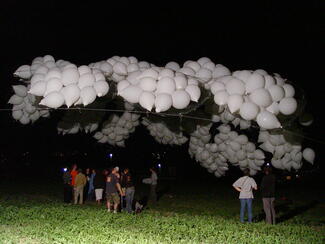

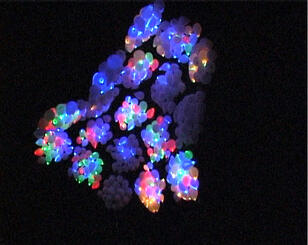
credit Shade Abdul
Sky Ear project - Usman Hague, 2004
Electromagnetic fields (EMF) exist just about everywhere in our atmosphere. Urban locations in particular have a diverse and vibrant hertzian culture, with mobile phone calls overlapping text messages, combining television broadcasts with garage door openers that interfere with radio transmissions and wireless laptops, etc., not to mention the natural EMF that already exists in the atmosphere. This project is a spatial investigation of some of these phenomena.
Sky Ear is a non-rigid carbon-fibre “cloud”, embedded with one thousand glowing helium balloons and several dozen mobile phones. The balloons contain miniature sensor circuits that respond to electromagnetic fields, particularly those of mobile phones. When activated, the sensor circuits co-ordinate to cause ultra-bright coloured LEDs to illuminate. The 30m cloud glows and flickers brightly as it floats across the sky.
As people using phones at ground-level call into the cloud (flying up to 100m above them) they are able to listen to distant natural electromagnetic sounds of the sky (including whistlers and spherics). Their mobile phone calls change the local hertzian topography; these disturbances in the electromagnetic fields inside the cloud alter the glow patterns of that part of the balloon cloud. Feedback within the sensor network creates ripples of light reminiscent of rumbling thunder and flashes of lightning.
Sky Ear shows both how a natural invisible electromagnetism pervades our environment and also how our mobile phone calls and text messages delicately affect the new and existing electromagnetic fields.
source: http://www.haque.co.uk
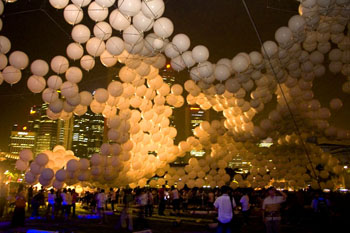
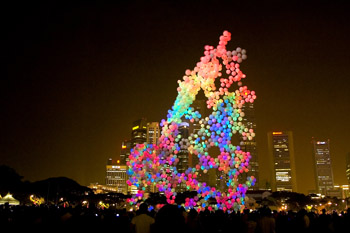
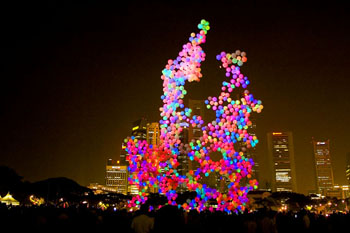
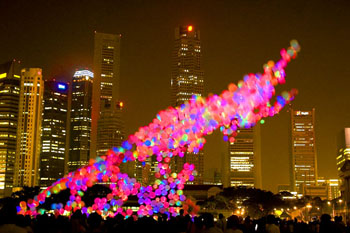
Open Burble - Usman Haque, Commissioned for the Singapore Biennale 2006
In this project, participants come together to compose, assemble and control an immense 'wall' of illuminated balloons constructed from a set of modular and configurable components. Just as the participants are the composers of the Burble's tall form, so too are they the ones to control it. They hold on to it using handles with which they may position the Burble as they like. They may curve in on themselves, or pull it in a straight line - the form is a combination of the crowd's desires and the impact of wind currents varying throughout the height of the Burble.The Burble moves, rustles, tangles, folds in on itself and creates turbulence as the wind catches it like a sail. Suddenly, the entire construction ignites with colour, sparkling in the evening sky.As people on the ground shake and pump the handle bars of the Burble, they see their movements echoed as colours through the entire system. They see their own individual fragments, perhaps even identifying design choices they have made. Their invididual contributions become an integral part of a spectacular, ephemeral experience many times their size that they have come together to produce.
source: http://www.haque.co.uk

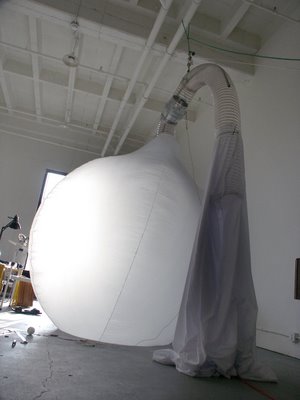
The installation consists of large air-bags or “bubbles” of permeable rip-stop nylon that inflate and deflate in reaction to visitors pushing or bumping the lower inflated volume of each pair. As visitors enter and move through the installation, they must navigate through the lightweight 8’ diameter spheres that fill the space. When the bubbles are bumped, sensors initiate a chaotic exchange of air between the spheres. When no visitors are present, the system returns to its stand-by state: the lower bubble in the pair refillls with air and awaits another interaction.
At their center is a hard “seed”- The seed serves two functions: it contains a micro-fluorescent lighting element to make the bubble glow, and it houses the sensor used to trigger the fan that deflates one bubble while inflating another.Bubbles was created by Michael Fox, Scott Franklin, Axel Kilian, Miao Miao, Juintow Lin, Darius Miller, and a number of volunteers.
source: http://www.emanate.org/
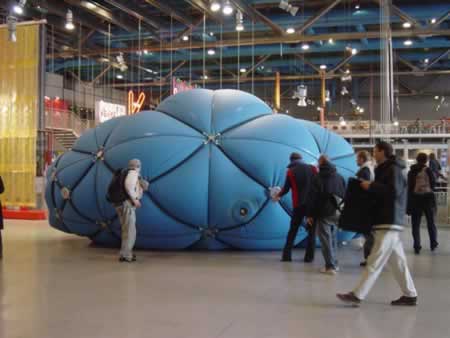
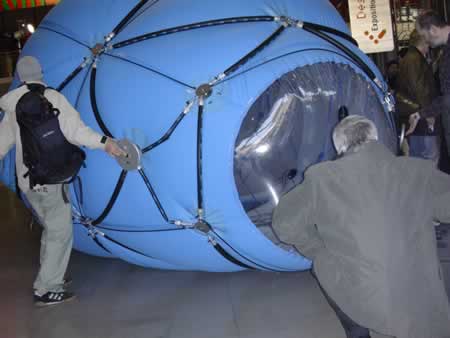
Muscle NSA - 2003 - Centre Pompidou Paris, NSA exhibition
Bontron The MUSCLE programmable building is a pressurized soft volume wrapped in a mesh of tensile muscles, which change length, height and width by varying the pressure pumped into the muscle. Visitors play a collective game to explore the different states of the MUSCLE. The public interacts with the MUSCLE by entering the interactivated sensorial space surrounding the prototype. This invisible component of the installation is implemented as a sensor field created by a collection of sensors. The sensors create a set of distinct shapes in space that, although invisible to the human eye, can be monitored and can yield information to the building body. The body senses the activities of the people and interacts with the players in a multimodal way. The public discovers within minutes how the MUSCLE behaves on their actions, and soon after they start finding a goal in the play.The outcome of this interaction however is unpredictable, since the MUSCLE is programmed to have a will of its own. It is pro-active rather then responsive and obedient. The programmable body is played by its users. A constant play of conjointly effectuating (re)actions, of attraction and repulsion between all players involved. This game truly is a multi-player game. Now true communication is established, where the pro-active parties involved alternately sense, process, and actuate in this constant loop of mutual influence. The players experience this parametric game of architecture as a form of serious fun. The playing of the game means setting the parameters.
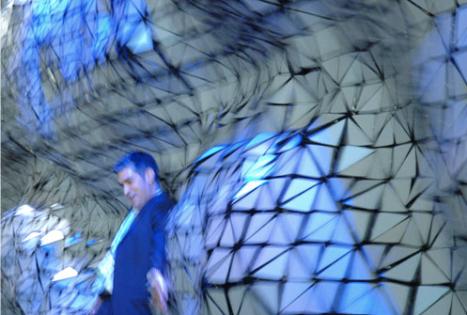
Venice Bienale International Pavilion, Italy, 2000, by Evan Ackerman
Walls. They’re so boring. And they’re everywhere. HypoSurface smashes through the, uh, fourth wall with a shape changing, interactive surface. Using interlocking flexible panels activated by compressed air from behind the wall, HypoSurface can create three dimensional waves, patterns, images, and even words by moving the flexible panels in sync. Software allows the wall to react to sound or movement, and… “the hypo surface allows the participant to connect and interact with a massive powerfull force - its like controlling a waterfall”
source: ohgizmo.com/category/technology/
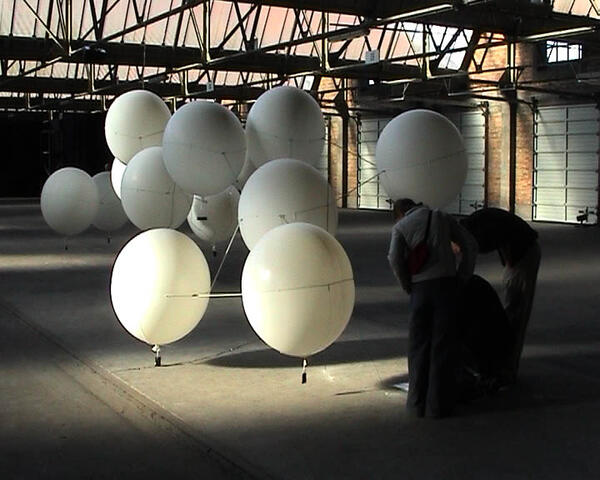
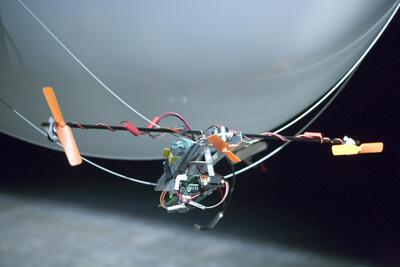
Thoughts go by air, Machine Cent'red Humanz 2003-2007
'Thoughts go by air' is a slowly evolving project within the domain of art and technology. The first generation (2003) existed of a bunch of balloons strapped together by wires and reacting on human or its own movements. For the second generation (2004), mxHz.org developed its own electronics with a sonar, motor control and communication protocols. This allowed the artbots to sense the environment and communicate with each other either in the same room or over the internet to another location. Connections between Brussels, Berlin, and New York were succesfully established.
source http://okno.be/?id=1035 http://mxhz.org/
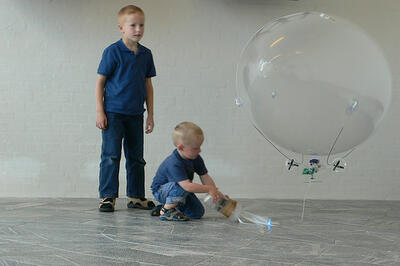
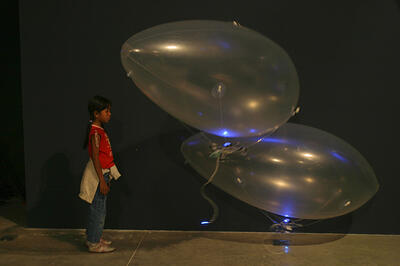
ALAVs 2.0 (Autonomous Light Air Vessels) are networked objects that communicate the concept of connectivity among people, objects, and the environment. Through the use of mobile technologies people can influence the behavior of the ALAVs by starting conversations and building closer relationships with them. ALAVs 2.0 reflects upon the current state of connectivity in our everyday lives. The potential of ALAVs 2.0 lies in its ability to captivate a wide audience and communicate the idea of people cohabiting a shared space with networked objects.
A project by Jed Berk, Julian Bleecker and Nikhil Mitter.
source: http://www.alavs.com/
more inflatable with image sections: Experience Inflatables - Powered by Wind - Parasite Inflatables - Soap Experiences - When Nature Inflates - Environmental Blendings - Hardened Bubbles - Inflatable Spaces - Inflatable Sound - Inflatable Wearables - The Non Categorized Inflatables - Lighter than Air - NASA Inflatables or go back to: Cocky Eek
Libarynth > Libarynth Web > CockyEek > InteractiveInflatables r11 - 14 Feb 2007 - 13:15 -
